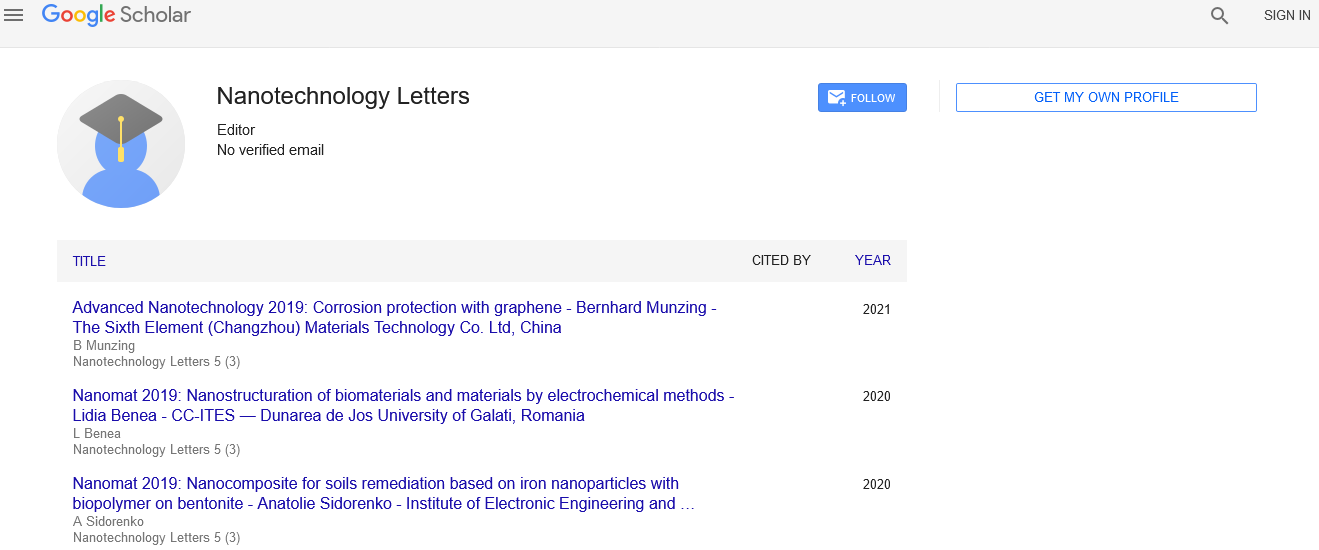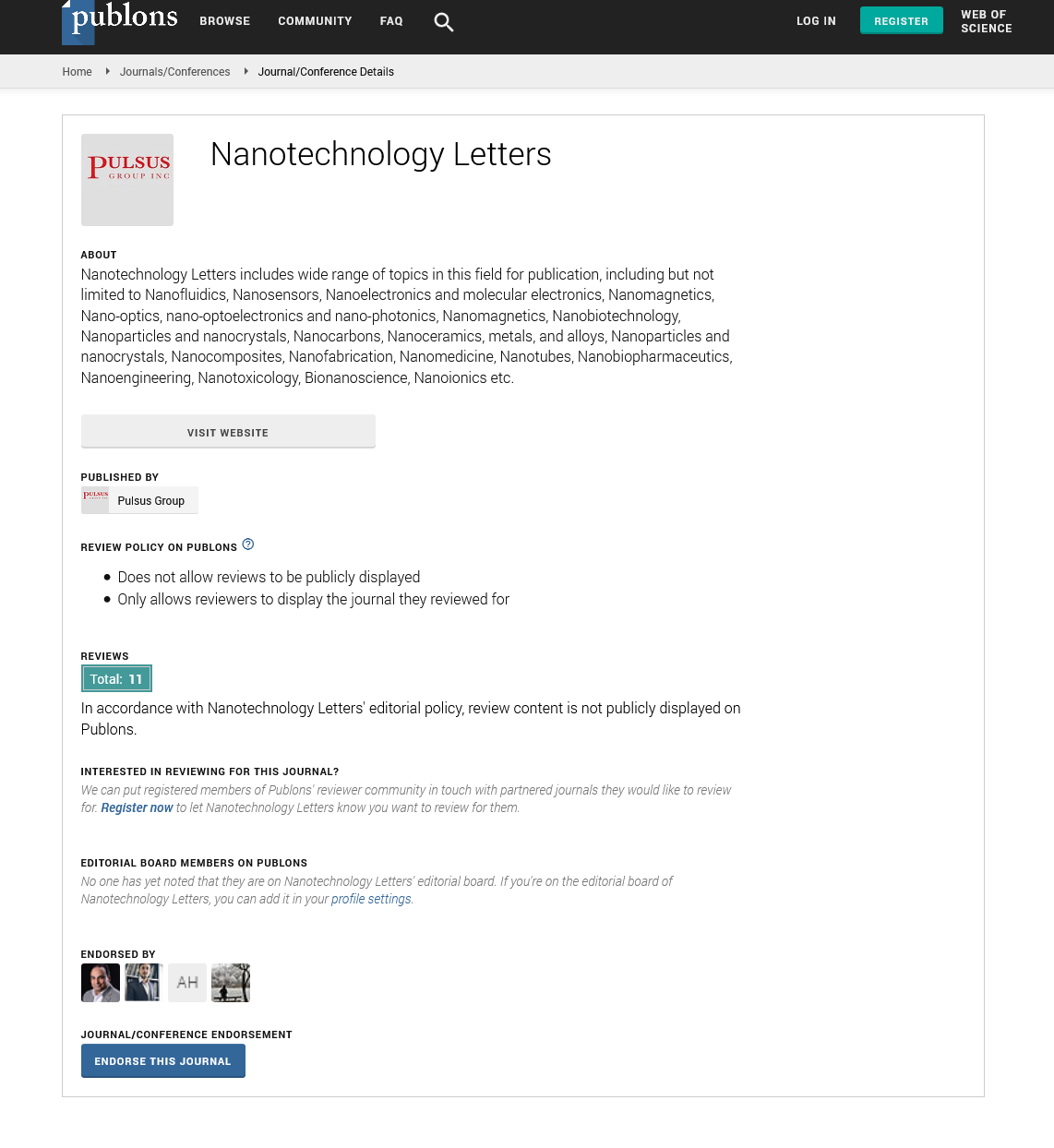Nano-magnetic resonance imaging revolutionizes personalized medicine
Received: 05-Mar-2023, Manuscript No. pulnl-23-6765; Editor assigned: 10-Mar-2023, Pre QC No. pulnl-23-6765 (PQ); Accepted Date: Mar 27, 2023; Reviewed: 18-Mar-2023 QC No. pulnl-23-6765 (Q); Revised: 23-Mar-2023, Manuscript No. pulnl-23-6765 (R); Published: 28-Mar-2023, DOI: 10.37532. pulnl.23.8 (2) 29-30
Citation: Hoffman. A. Nano-magnetic resonance imaging revolutionizes personalized medicine. Nanotechnol. lett.; 8(2):29-30
This open-access article is distributed under the terms of the Creative Commons Attribution Non-Commercial License (CC BY-NC) (http://creativecommons.org/licenses/by-nc/4.0/), which permits reuse, distribution and reproduction of the article, provided that the original work is properly cited and the reuse is restricted to noncommercial purposes. For commercial reuse, contact reprints@pulsus.com
Abstract
This article provides an overview of the significant recent breakthroughs in nanoscale Magnetic Resonance Imaging (nano-MRI) as applied to Personalized Medicine (PM). Nano-MRI has the potential to revolutionize conventional Magnetic Resonance Imaging (MRI) by enabling imaging at the nanometer scale and potentially, in the foreseeable future, at the atomic level. It holds the promise of visualizing structures that are currently beyond the reach of contemporary molecular imaging techniques, offering sensitivities that surpass today's clinical MRI by orders of magnitude. The paper briefly summarizes the key research areas in the field of nano-MRI.
Key Words
Personalized medicine; Nano-MRI; Recent developments
Introduction
Progress in Nano-MRI is advancing rapidly, thanks to the dedicated work of a small yet exceptionally talented group of experts. This paper is not meant to be an exhaustive technical review intended solely for this expert community. Instead, it aims to provide a concise account of current accomplishments in Nano-MRI that can be understood by a broader audience, particularly medical professionals. The objective is to bridge the gap between the NanoMRI specialists and those in the medical field who stand to benefit from the ongoing advancements in Nano-MRI, particularly as it pertains to specific medical objectives. This review seeks to underscore the potential of Nano-MRI in enhancing MRI sensitivity and, consequently, its profound impact on the field of diagnosis and personalized medical treatment. These sensitivity enhancements are realized through the utilization of magnetic nanoprobes in conventional MRI, as well as innovative nanoscale imaging methods centered around Nitrogen-Vacancy (NV) centers in diamonds.
PERSONALIZED MEDICINE
Early diagnosis and the precise customization of treatments for individual patients stand as the central objectives of Personalized Medicine (PM). PM is conceived as a system designed to deliver treatments with optimal timing, tailored to the unique needs of each patient. In medical imaging, inherent personalization is achieved through the assessment of abnormalities' geometry and location. This fundamental endeavor plays a crucial role in identifying suitable biomarkers for early intervention. Molecular imaging, rooted in these principles, is highly coveted for its potential to detect diseases even before symptoms manifest and to precisely administer medications. I facilitates the visualization of live tissue's physiological, biochemical, and biological processes, thereby enabling therapy, follow-up, and monitoring tailored to each patient. Moreover, it reduces the need for invasive treatments and paves the way for the concept of theranostics, which integrates therapeutics and diagnostics.
Theranostics draws a connection to nanotechnology, as advancements in nanoparticle production techniques and materials continually enhance their utility as imaging probes and drug carriers. This offers a significant advantage due to their ability to carry a substantial quantity of substances relative to their size. Currently explored agents span a wide range, from liposomal vesicle formulations functionalized with cytostatic compounds and contrast agents for Magnetic Resonance Imaging (MRI) to carbon nanotubes designed for the delivery of radioisotopes for both therapeutic and imaging purposes. Examples also include the use of engineered dendriworms for delivering small interfering ribonucleic acid for MRI or optical visualization. A novel strategy in this realm involves utilizing cells for both diagnostic and therapeutic purposes, an approach known as 'cellular theranostics.
MOLECULAR IMAGING
An essential technique in the implementation of personalized medicine is molecular imaging. This technique empowers the visualization of tissues within an organism without the need for their extraction for analysis. Molecular imaging serves various applications, including early disease detection through the visualization of cells and molecules, which allows for monitoring of biological processes and local biochemistry. Beyond disease diagnosis, molecular imaging also facilitates customized treatment and prognosis. To achieve this, it is imperative to efficiently cover the entire body while maintaining high sensitivity to disease markers. In this context, combined approaches such as Positron Emission Tomography (PET), Computed Tomography (CT), and diffusion-weighted MRI offer the capability to stage diseases and tailor treatments based on the results obtained from a single examination
Clinical imaging plays a crucial role in disease assessment by generating virtual representations of a patient's internal bodily structures. It collaborates with pathology to ensure accurate diagnoses. Molecular imaging has introduced a transformative dimension to clinical imaging, bridging imaging technology with molecular biology. This advancement enables the visualization of biochemical reactions at the molecular level within living organisms, in a non-invasive manner. A key aspect of molecular imaging involves the utilization of imaging probes, which are biomarkers that selectively bind to the molecules of interest, facilitating their visualization. This technology holds great promise for revolutionizing therapeutic approaches in oncology, neurology, and cardiovascular medicine.
Within this framework, Personalized Medicine (PM) stands to gain significantly from molecular imaging's capacity for early disease detection, treatment response prediction, and the development of novel drugs. It achieves this by optimizing drug candidate testing in both preclinical and clinical settings. Three emerging imaging techniques with specific applications in apoptosis, angiogenesis, and receptor targeting are poised to make substantial contributions to PM.
NANO-MAGNETIC RESONANCE IMAGING
Magnetic Resonance Imaging (MRI) is a technique that harnesses the electromagnetic response of tissues when subjected to a combination of magnetic and radio energy. This technology enables the imaging of tissues with enhanced spatial and temporal resolution. MRI offers excellent tissue contrast and the ability to penetrate tissues without depth limitations, allowing for the simultaneous acquisition of information about anatomical structures and their functionality. To address the inherent weaknesses of the magnetic signal and low detector sensitivity, contrast agents and amplification methods are often employed.
The choice between ferromagnetic and paramagnetic agents plays a pivotal role in determining whether positive or negative contrast can be achieved during the imaging process, ultimately enabling the visualization of structures at the cellular level. However, a significant challenge in the clinical application of these techniques, which are actively under research, lies in managing potential toxicity concerns associated with the sometimes substantial doses of contrast agents required for accurate imaging.
At the atomic level, impurities within diamonds have been harnessed as spin sensors, yielding impressive outcomes in nano-Magnetic Resonance Imaging (nano-MRI). These achievements are based on the exploitation of interactions between magnetic dipoles, replacing the need for induction-based detection methods. The most noteworthy achievements in nano-MRI involve the in vivo imaging of individual biomolecules at the nanometer scale under roomtemperature conditions. This remarkable progress has been made possible by employing Nitrogen-Vacancy (NV) centers within diamonds as highly sensitive sensors.
Nuclear spins are distinguished by their spin-lattice relaxation time, a length that imposes limitations on the utilization of hyperpolarized substances and weak spin-spin interactions within the realm of nanoMRI. However, this limitation can be extended by harnessing nuclear spin singlet states. Owing to their distinct symmetries, singlet and triplet states do not interact with each other. Thus, relaxation of the singlet state only occurs through higher-order, weak processes that involve adjacent spins.
NANOCRYSTALS
Another technique with substantial potential to transform the paradigms of medical diagnosis and treatment is based on nanocrystals. However, progress in this area has been somewhat limited due to the relatively recent introduction of this technology. Several challenges need to be addressed, including the enhancement of biocompatibility and colloidal stability under physiological conditions while maintaining the desired physical and chemical properties, such as a sufficiently small size. Once these challenges are overcome, it becomes possible to develop novel nano-bio hybrid systems with diverse capabilities in the realm of therapy and extremely high detection sensitivities. The utilization of magnetic nanocrystals as carriers for drug delivery and as probes for imaging and detection, particularly in Magnetic Resonance Imaging (MRI), holds the potential to significantly advance biomedical imaging. Such advancements are contingent upon compatibility with the biological environment.
Current MRI techniques, known for their non-invasive and tomographic capabilities with multiple dimensions, are powerful tools for medical diagnosis. However, they do face issues related to sensitivity and time resolution. These challenges can effectively be addressed by the introduction of magnetic nanocrystals. When an external magnetic field is applied to these nanocrystals within wet tissue, it perturbs the relaxation processes of nuclear spins in water molecules, particularly protons. This perturbation shortens the spinspin relaxation time T2 (a time constant characterizing the exponential decay of the transverse component of the magnetization vector toward its equilibrium value in NMR and MRI; T2 is associated with signal decay). Consequently, MRI images exhibit darker regions.
By combining nanocrystals with active biomaterials like antibodies, a dual effect is achieved: modulation of MR contrast and selective identification of target biomolecules. This approach serves as a means for molecular imaging, allowing for the detection of genetic and chemical changes within tissue, effectively signaling significant events.
Conclusions
This article serves as a concise exposition of the current accomplishments in nano-MRI, with the primary goal of bridging the divide between the nano-MRI community and medical professionals who stand to gain from the ongoing advancement of these techniques. In the long run, NV center magnetometry has the potential to bring about a revolution in MRI technology. Meanwhile, integrating nanocrystals into existing MRI protocols presents numerous short-term prospects that warrant further refinement and practical implementation.






